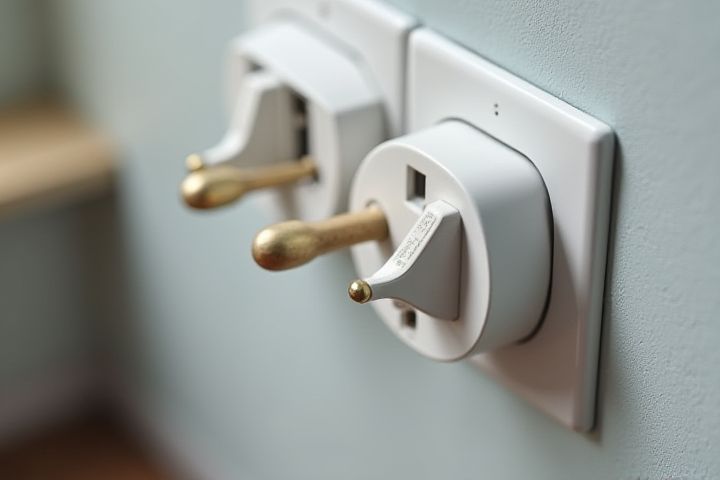
Strategically placing house outlets enhances convenience and functionality throughout your home. In living areas, position outlets near seating arrangements to optimize access for lamps, electronics, and charging devices. Bedrooms benefit from outlets on both sides of the bed, facilitating easy access to nightstand lamps and phone chargers. In kitchens, install outlets above countertops and near appliances like microwaves and coffee makers to streamline food preparation and cooking tasks. Don't forget outdoor outlets for powering garden tools and lighting, ensuring they are weatherproof and safely installed.
Where To Add House Outlets
Kitchen counter areas
Strategically positioning house outlets in kitchen counter areas enhances both functionality and safety. Place outlets near major appliances such as blenders, toasters, and coffee makers to minimize the need for extension cords. Installing outlets on the backsplash can help maintain a clean aesthetic while providing easy access for your devices. Ensure at least one outlet is placed on each counter section to accommodate multiple appliances and other kitchen gadgets efficiently.
Bathroom vanities
When planning outlets for bathroom vanities, prioritize installation near the mirror and sink for convenience. Codes typically require at least one outlet within 3 feet of the basin to power grooming devices like hairdryers or electric razors. Consider adding GFCI (Ground Fault Circuit Interrupter) outlets to enhance safety in wet areas. Positioning outlets inside drawers or behind cabinetry can also help maintain a tidy appearance while ensuring functionality.
Living room entertainment walls
In your living room, strategically place outlets on the entertainment wall to enhance your cable management and power connectivity for devices. Position outlets at a height of about 18 inches from the floor for easy access, especially behind entertainment units or TV stands. Incorporate additional outlets on either side of the wall to accommodate gaming consoles, streaming devices, or sound systems without cluttering the area. Consider installing an outlet with USB ports for convenient charging of gadgets, ensuring your space remains organized and functional.
Bedroom nightstand zones
When planning to add house outlets in bedroom nightstand zones, prioritize convenience and accessibility for your electronic devices. Position outlets on the wall adjacent to each nightstand, ideally at a height that allows easy access while sitting on the bed. Consider incorporating USB outlets for charging smartphones or tablets, as these are increasingly essential for modern living. Ensure your outlets comply with safety standards, which might include GFCI protection, especially if near sources of moisture.
Home office desks
When planning the placement of house outlets around your home office desk, prioritize accessibility and convenience. Position outlets within easy reach of your desk to accommodate essential devices like computers, monitors, and printers. Consider adding outlets on both sides of the desk to maximize flexibility for charging multiple devices simultaneously. Additionally, installing power strips or surge protectors can help manage cable clutter and provide extra outlets for gadgets such as lamps and smartphones.
Outdoor patios or decks
When planning to add house outlets to your outdoor patios or decks, consider positioning them near seating areas for convenient access to power for lighting, charging devices, or powering outdoor appliances. Placing outlets at the edges of your deck can allow for potential future uses, such as electric grills or landscape lighting. Ensure that outlets are weather-resistant and compliant with local electrical codes for safety and functionality. Remember, strategic outlet placement can significantly enhance your outdoor living experience and connectivity.
Entryways or foyers
Entryways or foyers are ideal locations for house outlets to enhance convenience and functionality. Placing outlets near the entry door allows you to easily charge devices or plug in decorative lighting, improving accessibility for guests. Consider adding outlets at varying heights to accommodate charging stations for phones, tablets, or even decorative elements like wall-mounted lamps. A well-placed outlet near a bench or seating area also provides a perfect solution for homeowners to utilize for everyday essentials, such as keys or bags with integrated chargers.
Garage workbenches
When planning your garage workbench, strategically position electrical outlets for optimal functionality. Place outlets at least 36 inches above the floor, ensuring easy access while working on various projects. Consider adding multiple outlets along the wall where your workbench will be, allowing you to plug in power tools and lighting without inconvenience. Also, include outlets on both sides of the workbench if space permits, enhancing accessibility for both right-handed and left-handed tasks.
Laundry rooms
In laundry rooms, strategically placing outlets enhances functionality and safety. Install dedicated outlets near washing machines to power them efficiently, while ensuring they are GFCI (Ground Fault Circuit Interrupter) protected to prevent electrical hazards. Consider adding outlets above countertop areas for powering folding stations or appliances like steamers and irons, optimizing your workspace. Lastly, including additional outlets near dryers facilitates the use of drying racks or other laundry-related equipment without overcrowding existing power sources.
Hallways and stair landings
For optimal convenience, consider adding house outlets in strategic locations such as hallways and stair landings. Placing outlets every 12 feet along the hallway ensures easy access for lighting, charging devices, and vacuuming. On stair landings, a dual outlet can effectively support decorative lighting or accent features while improving safety during nighttime navigation. Ensure that these outlets are installed at least 18 inches above the floor for accessibility and to prevent tripping hazards.
